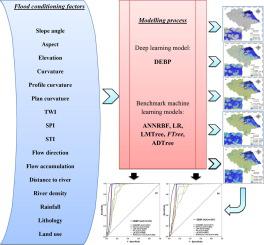当前位置:
X-MOL 学术
›
J. Hydrol.
›
论文详情
Our official English website, www.x-mol.net, welcomes your
feedback! (Note: you will need to create a separate account there.)
Can Deep Learning Algorithms Outperform Benchmark Machine Learning Algorithms in Flood Susceptibility Modeling?
Journal of Hydrology ( IF 5.9 ) Pub Date : 2021-01-01 , DOI: 10.1016/j.jhydrol.2020.125615 Binh Thai Pham , Chinh Luu , Tran Van Phong , Phan Trong Trinh , Ataollah Shirzadi , Somayeh Renoud , Shahrokh Asadi , Hiep Van Le , Jason von Meding , John J. Clague
Journal of Hydrology ( IF 5.9 ) Pub Date : 2021-01-01 , DOI: 10.1016/j.jhydrol.2020.125615 Binh Thai Pham , Chinh Luu , Tran Van Phong , Phan Trong Trinh , Ataollah Shirzadi , Somayeh Renoud , Shahrokh Asadi , Hiep Van Le , Jason von Meding , John J. Clague

|
Abstract This paper introduces a new deep-learning algorithm of deep belief network (DBN) based on an extreme learning machine (ELM) that is structured by back propagation (BN) and optimized by particle swarm optimization (PSO) algorithm, named DEBP, for flood susceptibility mapping in the Vu Gia-Thu Bon watershed, central Vietnam. We use 847 locations of floods that occurred in 2007, 2009, and 2013 and 16 flood conditioning factors evaluated by an information gain ratio (IGR) technique to construct and validate the proposed model. Statistical metrics, including sensitivity, specificity, accuracy, F1-measure, Jaccard coefficient, Matthews correlation coefficient (MCC), root mean square error (RMSE), and area under the receiver operating characteristic curve (AUC), are used to assess the goodness-of-fit/performance and prediction accuracy of the new deep learning model. We further compare the proposed model with several well-known machine learning algorithms, including artificial neural network-based radial base function (ANNRBF), logistic regression (LR), logistic model tree (LMTree), functional tree (FTree), and alternating decision tree (ADTree). The new proposed model, DEBP, has the highest goodness-of-fit (AUC = 0.970) and prediction accuracy (AUC = 0.967) of all of the tested models and thus shows promise as a tool for flood susceptibility modeling. We conclude that novel deep learning algorithms such as the one used in this study can improve the accuracy of flood susceptibility maps that are required by planners, decision makers, and government agencies to manage of areas vulnerable to flood-induced damage.
中文翻译:

深度学习算法能否在洪水敏感性建模中胜过基准机器学习算法?
摘要 本文介绍了一种基于极限学习机 (ELM) 的深度信念网络 (DBN) 深度学习新算法,该算法由反向传播 (BN) 构造并通过粒子群优化 (PSO) 算法优化,名为 DEBP,用于越南中部 Vu Gia-Thu Bon 流域的洪水敏感性绘图。我们使用 2007、2009 和 2013 年发生的 847 个洪水地点以及通过信息增益比 (IGR) 技术评估的 16 个洪水调节因子来构建和验证所提出的模型。统计指标,包括敏感性、特异性、准确性、F1-measure、Jaccard 系数、Matthews 相关系数 (MCC)、均方根误差 (RMSE) 和受试者工作特征曲线下面积 (AUC),用于评估新深度学习模型的拟合优度/性能和预测准确性。我们进一步将提出的模型与几种著名的机器学习算法进行比较,包括基于人工神经网络的径向基函数(ANNRBF)、逻辑回归(LR)、逻辑模型树(LMTree)、功能树(FTree)和交替决策树(ADTree)。新提出的模型 DEBP 在所有测试模型中具有最高的拟合优度 (AUC = 0.970) 和预测精度 (AUC = 0.967),因此有望作为洪水敏感性建模工具。我们得出的结论是,本研究中使用的新型深度学习算法可以提高规划者、决策者、
更新日期:2021-01-01
中文翻译:

深度学习算法能否在洪水敏感性建模中胜过基准机器学习算法?
摘要 本文介绍了一种基于极限学习机 (ELM) 的深度信念网络 (DBN) 深度学习新算法,该算法由反向传播 (BN) 构造并通过粒子群优化 (PSO) 算法优化,名为 DEBP,用于越南中部 Vu Gia-Thu Bon 流域的洪水敏感性绘图。我们使用 2007、2009 和 2013 年发生的 847 个洪水地点以及通过信息增益比 (IGR) 技术评估的 16 个洪水调节因子来构建和验证所提出的模型。统计指标,包括敏感性、特异性、准确性、F1-measure、Jaccard 系数、Matthews 相关系数 (MCC)、均方根误差 (RMSE) 和受试者工作特征曲线下面积 (AUC),用于评估新深度学习模型的拟合优度/性能和预测准确性。我们进一步将提出的模型与几种著名的机器学习算法进行比较,包括基于人工神经网络的径向基函数(ANNRBF)、逻辑回归(LR)、逻辑模型树(LMTree)、功能树(FTree)和交替决策树(ADTree)。新提出的模型 DEBP 在所有测试模型中具有最高的拟合优度 (AUC = 0.970) 和预测精度 (AUC = 0.967),因此有望作为洪水敏感性建模工具。我们得出的结论是,本研究中使用的新型深度学习算法可以提高规划者、决策者、









































 京公网安备 11010802027423号
京公网安备 11010802027423号